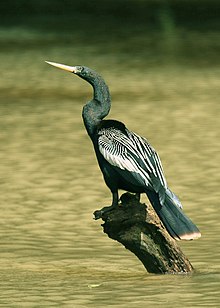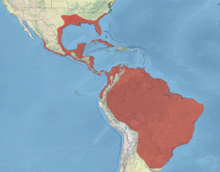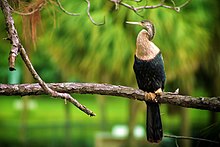Anhinga
| Anhinga Temporal range:
| |
|---|---|

| |
| Male in Costa Rica | |
| Scientific classification | |
| Domain: | Eukaryota |
| Kingdom: | Animalia |
| Phylum: | Chordata |
| Class: | Aves |
| Order: | Suliformes |
| Family: | Anhingidae |
| Genus: | Anhinga |
| Species: | A. anhinga
|
| Binomial name | |
| Anhinga anhinga (Linnaeus,1766)
| |
| Subspecies | |
|
A. a. anhinga | |

| |
| Range ofA. anhinga Breeding range Resident range
| |
| Synonyms | |
|
Plotus anhingaLinnaeus, 1766 | |

Theanhinga(/ænˈhɪŋɡə/;Anhinga anhinga), sometimes calledsnakebird,darter,American darter,orwater turkey,is a water bird of the warmer parts of the Americas. The wordanhingacomes froma'ñingain the BrazilianTupi languageand means "devil bird" or "snake bird".[3]The origin of the name is apparent when swimming: only the neck appears above water, so the bird looks like a snake ready to strike. They do not have external nares (nostrils) and breathe solely through theirepiglottis.
The anhinga is placed in the darter family,Anhingidae,and is closely related toIndian(Anhinga melanogaster),African(Anhinga rufa), andAustralian(Anhinga novaehollandiae)darters.Like other darters, the anhinga hunts by spearing fish and other small prey using its sharp, slender beak.
Distribution and migration
[edit]Members of theAnhingagenus live in warm, shallow waters and swamplands worldwide.[4]The American anhinga has been subdivided into two subspecies,A. a. anhingaandA. a. leucogaster,based on their respective location.A. a. anhingacan be found mainly east of theAndesinSouth America,east to the islands ofTrinidad and Tobago.A. a. leucogastercan be found in thesouthern United States,Mexico,Cuba,and theCaribbeanisland ofGrenada.[5]A fossil species,Anhinga walterbolesi,has been described from theLate OligocenetoEarly MioceneofAustralia.
Only birds living in the extreme north or south of their respective ranges willmigratebased on temperature and available sunlight; anhinga will travel closer towards theequatorduring winter, but this range is "determined by the amount of sunshine to warm the chilled birds".[4]Although not part of their traditional range, American anhinga have been found as far north as the states ofPennsylvania,[6]Wisconsin,[7]andNew York.[8]
Kettlesof anhinga often migrate with other species of birds, and have been described as resembling "black paper gliders".[9]
Description
[edit]The anhinga is a large bird, measuring approximately 89 cm (35 in) in length (with a range of 75–95 cm (30–37 in)), with a 1.14 m (3.7 ft) wingspan.[10][11]TheA. a. anhingasubspecies is larger thanA. a. leucogasterand has broader buffy tail tips.[5]They weigh on average around 1.22 kg (2.7 lb), with a range of 1.04–1.35 kg (2.3–3.0 lb).[11][12][13]The bill is relatively long (about twice the length of the head), sharply pointed, and yellow, and the webbed feet are yellow as well.[7][14][10][12]
The male is a glossy black-green with the wings, base of wings, and tail a glossy black-blue.[14]The tip of the tail is white.[15]The back of the head and the neck have elongated feathers that have been described as gray[16]or light purple-white.[14]The upper back of the body and wings are spotted or streaked with white.[16]
The female anhinga is similar to the male except for its pale gray-buff[17]or light brown[18]head, neck, and upper chest. The lower chest or breast is a chestnut color, and the back is browner than the male's.[19]
The hatchling starts bald but gains tan down within a few days of hatching. Within two weeks, the tan down is replaced by white down. Three weeks after hatching, the first juvenile feathers appear. Juveniles are mostly brown until they first breed, usually after the second or third winter.[4]
This bird is often mistaken for thedouble-crested cormorantdue to its similar size and shape, although the two species can be differentiated by their tails and bills. The tail of the anhinga is wider and much longer than the cormorant's. The bill of the anhinga is pointed, while the bill of the cormorant has a hook-tip.[20]
Behavior
[edit]Anhinga swim by kicking theirwebbed feetto pursue their prey, fish or amphibians, underwater, which they spear by rapidly outstretching their bent neck. They come up to the surface to consume and swallow prey.[21]Unlikeducks,ospreysandpelicans,which coat their feathers with oils from theuropygial gland,the anhinga does not have this ability; anhinga lack waterproof feathers on their bodies, causing them to be saturated upon immersion into water, while the flight feathers are slightly less wettable. Thus, their habit of basking in the sun with outstretched wings is crucial. Their dense bones, wetted plumage, and neutralbuoyancywhen in water allows them to fully submerge and hunt for underwater prey.[22][23]
The anhinga cannot fly for any extended distance with soaked feathers; if they attempt to fly while wet, notable difficulty is experienced, the birds flapping vigorously while "running" on the water’'s surface for a short distance (often escaping a perceived threat). Likecormorants,anhingas perch and rest on fallen trees, logs or rocks near the water's edge with wings spread and feathers fanned-open in a semicircular shape, facing away from the sun, in order to dry themselves and absorb the sun's heat.[24]Anhingas also lose body heat relatively fast, and their posture helps them absorb solar radiation from the sun to counteract this.[24]Because an anhinga in the drying position resembles a maleturkey,it has been colloquially referred to as the 'water turkey' or 'swamp turkey'.
Diet
[edit]
Anhingas feed on moderately sized wetland fishes,[11]amphibians,[25]aquatic invertebrates and insects.[26]InAlabama,the anhinga's diet consists of fishes (such asmullet,sunfish,black bass,catfish,suckers,andchain pickerel),crayfish,crabs,shrimp,aquatic insects,tadpoles,water snakesand smallterrapins.[27]In Florida,sunfishes and bass,killifishes,andlive-bearing fishesare primarily eaten by the anhingas.[28]Other fish eaten includepupfishandpercids.[26]
Anhingas stalk fish underwater, mainly where there is some vegetation. Once they locate their prey, they partly open their bill and stab the fish swiftly. For larger fish, they use both their jaws; for small fish they may use only the lower jaw.[11]If the fish is too large to forage, the anhinga stabs it repeatedly and then lets it go.[29]The anhingas bring their capture to the surface of the water, toss it backward and engulf it head-first.[28]
Conservation status
[edit]The US protects the anhinga under theMigratory Bird Treaty Act of 1918.[30]The number of individual anhingas has not been estimated, but they are considered to be of least concern because of the frequency of their occurrence in their 15,000,000 km2(5,800,000 sq mi) global range.[1]
-
Male drying its feathers and warming its body, Florida, US
-
Showing snake-like neck and pointed beak
-
In flight, South Carolina, US
-
Juvenile in Uarini, Amazonas, Brazil
-
Juveniles with white plumage
-
Female in Florida, US
References
[edit]- ^abBirdLife International (2016)."Anhinga anhinga".IUCN Red List of Threatened Species.2016:e.T22696702A93581588.doi:10.2305/IUCN.UK.2016-3.RLTS.T22696702A93581588.en.Retrieved13 November2021.
- ^"Anhinga anhinga".NatureServeExplorer.Retrieved17 April2024.
- ^Ferreira, A. B. H. (1986).Novo Dicionário da Língua Portuguesa.Second edition. Rio de Janeiro: Nova Fronteira. p. 123.
- ^abcNellis, David W. (2001).Common Coastal Birds of Florida and the Caribbean.Pineapple Press, Inc. p. 110.ISBN978-1-56164-191-8.
- ^abBlake, Emmet Reid (1953).Birds of Mexico: a guide for field identification.University of Chicago Press. pp.151–152.ISBN0-226-05641-4.
- ^McWilliams, Gerald M.; Brauning, Daniel W. (1999).Birds of Pennsylvania.Cornell University Press. p. 43.ISBN978-0-8014-3643-7.
- ^abRobbins, Samuel D. (1991).Wisconsin Birdlife: Population and Distribution Past and Present.University of Wisconsin Press. pp. 127–128.ISBN978-0-299-10260-9.
- ^"The 'Devil Bird' Lands in New York, With More Likely to Come",The New York Times,4 May 2023
- ^Eubanks, Ted L.; Behrstock, Robert A.; Weeks, Ron J. (2006).Birdlife of Houston, Galveston, and the Upper Texas Coast.Texas A&M University Press. p. 70.ISBN978-1-58544-510-3.
- ^abSibley, David Allen(2003).The Sibley Field Guide to Birds of Eastern North America.New York: Alfred A. Knopf. p. 45.ISBN0-679-45120-X.
- ^abcd"Anhinga".All About Birds.Cornell Lab of Ornithology.
- ^abMaehr, David S.; Kale, H.W.; Kale, II, Herbert W. (2005).Florida's Birds: A Field Guide and Reference.Pineapple Press Inc. pp. 33, 38.ISBN1-56164-335-1.
- ^Hennemann, III, Willard W. (December 1985). "Energetics, Behavior and the Zoogeography of Anhingas and Double-Crested Cormorants".Ornis Scandinavica.16(4). Wiley: 319–323.doi:10.2307/3676697.JSTOR3676697.
- ^abcAudubon, John James (1843).The Birds of America.J.B. Chevalier. pp.443–457.
- ^Wood, Tom; Williamson, Sheri L.; Glassberg, Jeffrey (2005).Birds of North America.Sterling Publishing Company, Inc. p. 50.ISBN1-4027-2821-2.
- ^abChapman, Frank M. (1904).Handbook of Birds of Eastern North America(PDF).Harvard University. p. 93.doi:10.5962/bhl.title.34046.
- ^Burton, Maurice; Burton, Robert (2002).International Wildlife Encyclopedia.Marshall Cavendish. pp.646.ISBN0-7614-7271-1.
- ^Gregware, Bill; Gregware, Carol (1997).Guide to the Lake Okeechobee Area.Pineapple Press Inc. p. 54.ISBN1-56164-129-4.
- ^Fjeldså, Jon; Krabbe, Niels; Jørgensen, Povl; Byskov, Jens Ole (1990).Birds of the High Andes.Apollo Books. p. 74.ISBN87-88757-16-1.
- ^Peterson, Roger Tory(1998).A Field Guide to the Birds of Texas.Houghton Mifflin Harcourt. p. 130.ISBN0-395-92138-4.
- ^Frederick, P. C. and D. Siegel-Causey (2000). Anhinga (Anhinga anhinga), version 2.0. In The Birds of North America (A. F. Poole and F. B. Gill, Editors). Cornell Lab of Ornithology, Ithaca, NY, USA. Pg 4-5DOI:10.2173/bna.522
- ^"Anhinga - Introduction".Birds of North America Online.Archivedfrom the original on 2018-06-05.Retrieved2018-12-08– via website:birdsna.org.
- ^Rijke, Arie M.; Jesser, William A.; Mahoney, Sheila A. (1989)."Plumage wettability of the African darter Anhinga melanogaster compared with the double-crested cormorant Phalacrocorax auritus".Ostrich.60(3): 128–132.Bibcode:1989Ostri..60..128R.doi:10.1080/00306525.1989.9633739.ISSN0030-6525.
- ^abHennemann, Willard W. "Energetics and Spread-Winged Behavior of Anhingas in Florida"The Condor84, no. 1 (1982): 91-96.JSTOR1367827
- ^"The Online Guide to the Animals of Trinidad and Tobago - Anhinga anhinga (Anhinga or Snake-bird)"(PDF).
- ^abKearns, Laura."ADW: Anhinga anhinga: INFORMATION".Animaldiversity.org.Retrieved2022-08-08.
- ^Imhof, Thomas, A (1962).Alabama Birds.University of Alabama Press.ISBN978-0-8173-1701-0.
{{cite book}}:CS1 maint: multiple names: authors list (link) - ^abOwre, Oscar, T (1967)."Adaptations for locomotion and feeding in the Anhinga and the Double-crested cormorant"(PDF).Ornithological Monographs(6). American Ornithologists Union: 126–127.doi:10.2307/40166666.ISBN978-0-9436-1006-1.JSTOR40166666.
{{cite journal}}:CS1 maint: multiple names: authors list (link) - ^Wellenstein, Charlie (1986). "Prey Handling by Anhingas".Florida Field Naturalist.14:74-75- viaSORA
- ^U.S. Fish and Wildlife Service (1995)."Birds Protected by the Migratory Bird Treaty Act".Archived fromthe originalon 8 May 2008.Retrieved15 September2008.
External links
[edit]- BirdLife species factsheet forAnhinga anhinga
- "Anhinga media".Internet Bird Collection.
- Anhinga photo galleryat VIREO (Drexel University)
- Audio recordings of AnhingaonXeno-canto.









